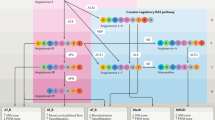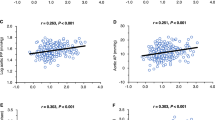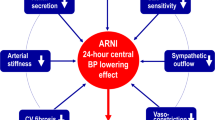Abstract
A renin-angiotensin level that is inappropriately high for the systemic blood pressure and the state of sodium balance is now recognized to be one of the modifiable cardiovascular risk factors. Angiotensin acts both as a circulating hormone and as a locally acting paracrine/autocrine/intracrine factor. The adverse effects of angiotensin on the heart include the mechanical results of elevated resistance to the pumping function of the myocardium, as well as the effects of neurohumoral abnormalities on various cardiac structures. In addition, cardiac damage follows acute ischaemic injury or chronic energy starvation due to coronary artery disease, attributable to either mechanical obstruction (atherosclerotic and/or thrombotic) or functional stenosis (vasospasm). Activation of the renin-angiotensin system has several haemodynamic and humoral consequences, all of which may damage the myocardium. These include acute myocardial ischaemia, left-ventricular hypertrophy, arrhythmias, alterations in the coagulation–fibrinolysis equilibrium, increased oxi- dative stress, and pro-inflammatory activity. A brief review of some of the mechanisms by which activation of the renin-angiotensin system can inflict damage on the heart is presented.
This is a preview of subscription content, access via your institution
Access options
Subscribe to this journal
Receive 12 digital issues and online access to articles
$119.00 per year
only $9.92 per issue
Buy this article
- Purchase on Springer Link
- Instant access to full article PDF
Prices may be subject to local taxes which are calculated during checkout
Similar content being viewed by others
References
Gavras H et al. Acute renal failure, tubular necrosis and myocardial infarction induced in the rabbit by intravenous angiotensin II Lancet 1971 2: 19–22
Gavras H et al. Angiotensin- and norepinephrine-induced myocardial lesions: experimental and clinical studies in rabbits and man Am Heart J 1975 89: 321–332
Tan LB et al. Cardiac myocyte necrosis induced by angiotensin II Circ Res 1991 69: 1185–1195
Weber KT, Brilla CG, Campbell SE, Reddy HK . Myocardial fibrosis and the concepts of cardioprotection and cardioreparation J Hypertens 1992 10 (Suppl 5): S87–S94
Liang C, Gavras H, Hood WB Jr . Renin-angiotensin system inhibition in conscious sodium-depleted dogs. Effects on systemic and coronary hemodynamics J Clin Invest 1978 61: 874–883
Gavras H, Liang C, Brunner HR . Redistribution of regional blood flow after inhibition of the angiotensin converting enzyme Circ Res 1978 43 (Suppl 1): S59–S63
Liang C, Gavras H . Renin-angiotensin system inhibition in conscious dogs during acute hypoxemia: effects on systemic hemodynamics, regional blood flows, and tissue metabolism J Clin Invest 1978 62: 961–970
Gavras H et al. Angiotensin II inhibition. Treatment of congestive cardiac failure in a high-renin hypertension JAMA 1977 238: 880–882
Faxon DP et al. The effect of angiotensin converting enzyme inhibition on coronary blood flow and hemodynamics inpatients without coronary artery disease Int J Cardiol 1982 2: 251–262
Magrini F et al. Converting-enzyme inhibition and coronary blood flow Circulation 1987 75 (Suppl 1): I168–I174
Mettauer B, Rouleau JL, Daly P . The effect of captopril on the coronary circulation and myocardial metab-olism ofpatients with coronary artery disease Postgrad Med J 1986 62 (Suppl 1): 54–58
Strozzi C et al. Effects of captopril on the physical work capacity of normotensivepatients with stable-effort angina pectoris Cardiology 1987 74: 226–228
Strozzi C, Portaluppi F, Cocco G, Urso L . Ergometric evaluation of the effects of enalapril maleate in normotensivepatients with stable angina Clin Cardiol 1988 11: 246–249
Gasic S, Dudczak R, Korn A, Kleinbloesem C . ACE inhibition with cilazapril improves myocardial perfusion to the ischemic regions during exercise: a pilot study J Cardiovasc Pharmacol 1990 15: 227–232
Savage DD et al. Echocardiographic assessment of cardiac anatomy and function in hypertensive subjects Circulation 1979 59: 623–632
Pauletto P et al. Ventricular myosin and creatine-kinase isoenzymes in hypertensive rats treated with captopril Hypertension 1989 14: 556–562
Rogers TB, Gaa ST, Allen IS . Identification and characterization of functional angiotensin II receptors on cultured heart myocytes J Pharmacol Exp Ther 1986 236: 438–444
Allen IS et al. Angiotensin II increases spontaneous contractile frequency and stimulates calcium current in cultured neonatal rat heart myocytes: insights into the underlying biochemical mechanisms Circ Res 1988 62: 524–534
Dostal DE, Baker KM . Evidence for a role of an intracardiac renin-angiotensin system in the normal and failing heart Trends Cardiovasc Med 1993 3: 67–74
Dostal DE, Baker KM . Biochemistry, molecular biology, and potential roles of the cardiac renin-angiotensin system. In: Dhalla NS, Beamish RE, Takeda N, Nagano M (eds) The Failing Heart Lippincott-Raven: Philadephia 1995 275–294
Yu C, Tsai M, Stacey DW . Cellular ras activity and phospholipid metabolism Cell 1988 52: 63–71
Knauss TC, Jaffer FE, Abboud HE . Phosphatidic acid modulates DNA synthesis, phospholipase C, and platelet-derived growth factor mRNAs in cultured mesangial cells. Role of protein kinase C J Biol Chem 1990 265: 14457–14463
Moolenaar WH et al. Growth factor-like action of phosphatidic acid Nature 1986 323: 171–173
Nagano M et al. Converting enzyme inhibitors regressed cardiac hypertrophy and reduced tissue angiotensin II in spontaneously hypertensive rats J Hypertens 1991 9: 595–599
Malik KU, Nasjletti A . Facilitation of adrenergic transmission by locally generated angiotensin II in rat mesenteric arteries Circ Res 1976 38: 26–30
Newling RP, Fletcher PJ, Contis M, Shaw J . Noradrenaline and cardiac hypertrophy in the rat: changes in morphology, blood pressure and ventricular performance J Hypertens 1989 7: 561–567
Campbell DJ . Circulating and tissue angiotensin systems J Clin Invest 1987 79: 1–6
Laragh JH . Extrarenal tissue prorenin systems do exist: are intrinsic vascular and cardiac tissue renins fact or fancy? Am J Hypertens 1989 2: 262–265
Goodfriend TL, Elliott ME, Catt KJ . Angiotensin receptors and their antagonists N Engl J Med 1996 334: 1649–1654
Griendling KK, Minieri CA, Ollerenshaw JD, Alexander RW . Angiotensin II stimulates NADH and NADPH oxidase activity in cultured vascular smooth muscle cells Circ Res 1994 74: 1141–1148
Ames BN, Shigenaga MK, Hagen TM . Oxidants, antioxidants, and the degenerative disease of aging Proc Natl Acad Sci USA 1993 90: 7915–7922
McAlpine HM, Cobbe SM . Neuroendocrine changes in acute myocardial infarction Am J Med 1988 84 (Suppl 3A): 61–66
Rouleau JL et al. Activation of neurohumoral systems following acute myocardial infarction Am J Cardiol 1991 68: 80D–86D
Braunwald E, Kloner RA . Myocardial reperfusion: a double-edged sword? J Clin Invest 1985 76: 1713–1719
Li K, Chen X . Protective effects of captopril and enalapril on myocardial ischemia and reperfusion damage of rat J Mol Cell Cardiol 1987 19: 909–915
Tio RA et al. The effects of oral pretreatment with zofenopril, an angiotensin-converting enzyme inhibitor, on early reperfusion and subsequent electrophysio-logic stability in the pig Cardiovasc Drugs Ther 1990 4: 695–703
Frei B . Reactive oxygen species and antioxidant vita-min: mechanisms of action Am J Med 1994 97 (Suppl 3A): S5–S13
Keaney JF, Frei B . Antioxidant protection of low-density lipoprotein and its role in the prevention of atherosclerotic vascular disease. In: Frei B (ed) Natural Antioxidants in Human Health and Disease Academic Press: Orlando 1994 303–351
Keidar S et al. Low density lipoprotein isolated frompatients with essential hypertension exhibits increased propensity for oxidation and enhanced uptake by macrophages: a possible role for angiotensin II Atherosclerosis 1994 107: 71–84
Brunner HR et al. Essential hypertension: renin and aldosterone, heart attack and stroke N Engl J Med 1972 286: 441–449
Alderman MH et al. Association of the renin-sodium profile with the risk of myocardial infarction inpatients with hypertension N Engl J Med 1991 324: 1098–1104
MacMahon SW, Cutler JA, Furberg CD, Payne GH . The effects of drug treatment for hypertension on morbidity and mortality from cardiovascolar disease: a review of randomized controlled trials ProgCardiovasc Dis 1986 29 (Suppl 1): S99–S118
Chobanian AV, Haudenschild CC, Nickerson C, Drago R . Antiatherogenic effect of captopril in the Watanabe heritable hyperlipidemic rabbit Hypertension 1990 15: 327–331
The SOLVD Investigators. Effect of enalapril on survival inpatients with reduced left ventricular ejection fractions and congestive heart failure N Engl J Med 1991 325: 293–302
The SOLVD Investigators. Effect of enalapril on mortality and the development of heart failure in asymp-tomaticpatients with reduced left ventricular ejection fractions N Engl J Med 1992 327: 685–691
Yusuf S et al. Effect of enalapril on myocardial infarction and unstable angina inpatients with low ejection fractions Lancet 1992 340: 1173–1178
Sprengers ED, Kluft C . Plasminogen activator inhibitors Blood 1987 69: 381–387
Ridker PM . An epidemiologic assessment of thrombotic risk factors for cardiovascular disease Curr Opin Lipidol 1992 3: 285–290
Hamsten A et al. Plasminogen activator inhibitor in plasma: risk factor for recurrent myocardial infarction Lancet 1987 2: 3–9
Olson JA Jr et al. Angiotensin II induces secretion of plasminogen activator inhibitor I and a tissue metalloprotease inhibitor-related protein from rat brain astrocytes Neurobiology 1991 88: 1928–1932
Ridker PM et al. Stimulation of plasminogen activator inhibitor in vivo by infusion of angiotensin II. Evidence of a potential interaction between the renin-angiotensin system and fibrinolytic function Circulation 1993 87: 1969–1973
Saito K, Gutkind JS, Saavedra JM . Angiotensin II binding sites in the conduction system of rat hearts Am J Physiol 1987 253: H1618–H1622
Kass RS, Blair ML . Effects of angiotensin II on membrane current in cardiac Purkinje fibers J Mol Cell Cardiol 1981 13: 797–809
de Mello WC . Is an intracellular renin-angiotensin system involved in control of cell communication in heart? J Cardiovasc Pharmacol 1994 23: 640–646
de Mello WC, Crespo MJ . Cardiac refractoriness in rats is reduced by angiotensin II J Cardiovasc Pharmacol 1995 25: 51–56
Rajagopalan S et al. Role for endothelin-1 in angiotensin II-mediated hypertension Hypertension 1997 30: 29–34
Starke K . Action of angiotensin on uptake, release, and metabolism of 14C-noradrenaline by isolated rabbit hearts Eur J Pharmacol 1971 14: 112–123
Aiken JW, Reit E . Stimulation of the cat stellate ganglion by angiotensin J Pharmacol Exp Ther 1968 159: 107–114
Lee WB, Ismay MJ, Lumbers ER . Mechanisms by which angiotensin affects the heart rate of the conscious sheep Circ Res 1980 47: 286–292
Ponikowski P et al. Heart rhythms, ventricular arrhythmias, and death in chronic heart failure J Cardiac Failure 1996 2: 177–183
de Mello WC, Crespo MJ, Altieri PI . Enalapril increases cardiac refractoriness J Cardiovasc Pharmacol 1992 20: 820–825
Kingma JH et al. Effects of intravenous captopril on inducible sustained ventricular tachycardia Postgrad Med 1986 62: 159–163
Wesseling H et al. Cardiac arrhythmias – a new indication for angiotensin-converting enzyme inhibitors? J Hum Hypertens 1989 3 (Suppl 1): 89–95
van Gilst WH, de Graeff PA, Wesseling H, de Langen CD . Reduction of reperfusion arrhythmias in the is-chemic isolated rat heart by angiotensin converting enzyme inhibitors: a comparison of captopril, enala-pril, and HOE 498 J Cardiovasc Pharmacol 1986 8: 722–728
Sharma D, Buyse M, Pitt B, Rucinska EJ . Meta-analysis of observed mortality data from all-controlled, double-blind, multiple-dose studies of losartan in heart failure Am J Cardiol 2000 85: 187–192
Elliott WJ . Therapeutic trials comparing angiotensin converting enzyme inhibitors and angiotensin II receptor blockers Curr Hypertens Rep 2000 2: 402–411
Kranzhofer R et al. Angiotensin induces inflammatory activation of human vascular smooth muscle cells Arterioscler Thromb Vasc Biol 1999 19: 1623–1629
Han Y, Runge MS, Brasier AR . Angiotensin II induces interleukin-6 transcription in vascular smooth muscle cells through pleiotropic activation of nuclear factor-kappa B transcription factors Circ Res 1999 84: 695–703
Author information
Authors and Affiliations
Corresponding author
Rights and permissions
About this article
Cite this article
Gavras, I., Gavras, H. Angiotensin II as a cardiovascular risk factor. J Hum Hypertens 16 (Suppl 2), S2–S6 (2002). https://doi.org/10.1038/sj.jhh.1001392
Published:
Issue Date:
DOI: https://doi.org/10.1038/sj.jhh.1001392
Keywords
This article is cited by
-
The triumvirate: why hypertension, obesity, and diabetes are risk factors for adverse effects in patients with COVID-19
Acta Diabetologica (2021)
-
An update on the lipid nephrotoxicity hypothesis
Nature Reviews Nephrology (2009)
-
Effect of Aldosterone and Mineralocorticoid Receptor Blockade on Vascular Inflammation
Heart Failure Reviews (2005)
-
Endothelin-1 and vasopressin plasma levels are not associated with the insertion/deletion polymorphism of the human angiotensin I-converting enzyme gene in patients with coronary artery disease
Journal of Human Hypertension (2003)
-
Insulin resistance and vascular remodelling, in relation to left ventricular mass, geometry and function: an answer to LIFE?
Journal of Human Hypertension (2003)



